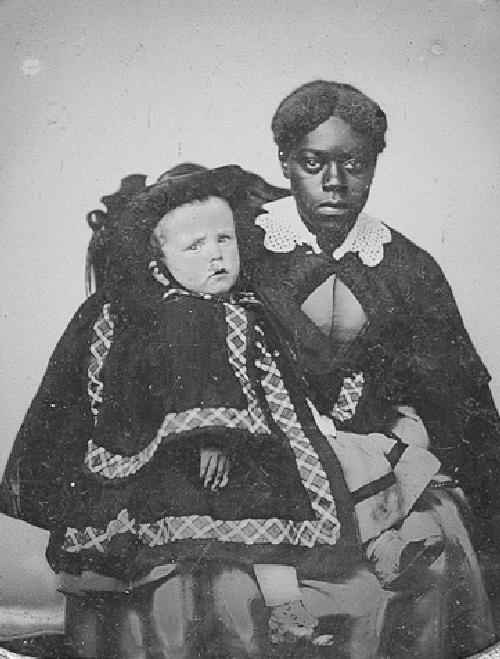
Slavery in America: Work Assignments

Figure 1.-- Another occupation for slaves, always slave women, as child care. This was one of the ironies of the slave system. Slave masters who often questioned the very humanity of their slaves, trusted them with their most precious possessions--their children.
|
|
The vast majority of the slaves in the deep South were involved in agricultural labor on large plantations. This is where the living and working conditions were often horendous. The principal crop was cotton and slaves were used to plant, hoe, and then pick the cotton balls. Picking was called "chopin" cotton. This was back breaking manual labor. Few of the slaves on these plantations were taught or developed skills. Except for the household slaves, few plantation slaves had personal relations with their owners. Some plantation slaves did learn trades to facilitate the plantation's operations, but this was a small minority. The slave owners were primarily focused on maximizing cotton production. Slaves in the border states were much more likely to be owned on small farms or small-scale pripertor like black smiths or carpeters. Thus they were thus more likely to have a closer worjing relationship with their owners. They were also more likely to have been taught trades and other skills. While slavery was an economic system primarily centered on agriculture, slaves were also used as servants to make live more pleasant. Another occupation for slaves, always slave women, was child care. This was one of the ironies of the slave system. Slave masters who often questioned the very humanity of their slaves, trusted them with their most precious ossessions--their children.
Agricultural Labor
The vast majority of the slaves in the deep South were involved in agricultural labor on large plantations. Cotton in ante-bellum America played a key roll in the national economy. It provided the raw material to the devloping textile industry of the North, America's first industry. It also generated the bulk of American export income. This is where the living and working conditions were often horendous. Cotton was a labor intensive crop. The principal crop was cotton and slaves were used to plant, hoe, and then pick the cotton balls. Picking was called "chopin" cotton. This was back breaking manual labor. Few of the slaves on these plantations were taught or developed skills. Except for the household slaves, few plantation slaves had personal relations with their owners. Some plantation slaves did learn trades to facilitate the plantation's operations, but this was a small minority. The slave owners were primarily focused on maximizing cotton production. Children at a very young age were put to work in agricultural labor. They might at first be given jobs like fetching water for the working slves.
Skilled Labor
Slaves in the border states were much more likely to be owned on small farms or small-scale pripertor like black smiths or carpeters. Thus they were thus more likely to have a closer working relationship with their owners. They were also more likely to have been taught trades and other skills.
Personal Servants
While slavery was an economic system primarily centered on agriculture, slaves were also used as servants to make live more pleasant. Another occupation for slaves, almost always slave women, was child care. This was one of the ironies of the slave system. Slave masters who often questioned the very humanity of their slaves, trusted them with their most precious ossessions--their children. The one exception to female slave nannies is that the children of plantation owners often had a slave child assign to them. They were nomally same gender children. Age relation varied. Sometimes they were about the same age. Other times the These slave children commonly were a little older than the white child. Thus they served the dual putrpose of play mate and minder to make sure a young child did not get hurt. Commonly they were threatened with punishment if the white child got hurt in some way. Not uncommonly the slave would go on to be a trusted personal servant as the white child grew up. The most famous such slave was Jupiter who grew up with the young Thomas Jefferson.
HBC

Navigate the Boys' Historical Clothing Web Site:
[Return to the Main American slavery page]
[Return to the Main working page]
[Introduction]
[Activities]
[Biographies]
[Chronology]
[Clothing styles]
[Countries]
[Bibliographies]
[Contributions]
[Essays]
[FAQs]
[Glossaries]
[Satellites]
[Tools]
[Boys' Clothing Home]
Created: December 31, 2003
Last updated: 7:47 AM 2/12/2006



